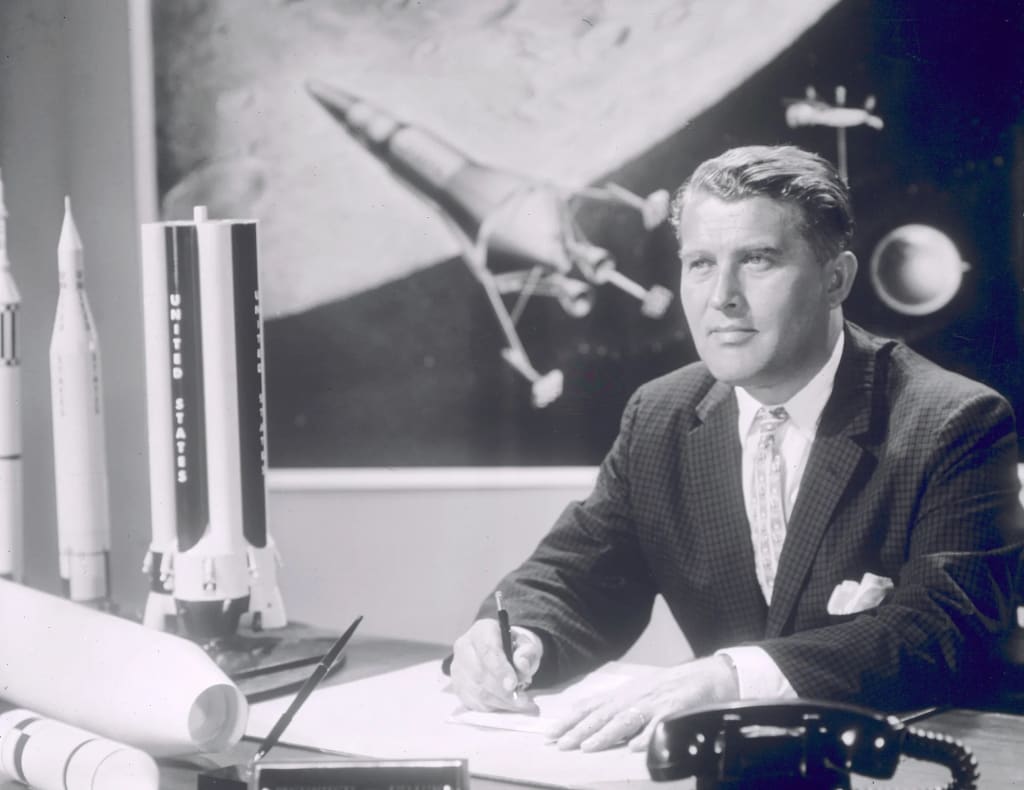
He is remembered as one of history's great rocket engineers, developing the giant Saturn V rocket that powered NASA's Apollo missions to the Moon in the 1960s.
His past as a scientist working for Nazi Germany remains shrouded in controversy.
This is the story of Wernher von Braun, the brilliant rocket scientist… and the war criminal.
Early work in Germany
Wernher von Braun was born in 1912 in Germany, and from an early age had a fascination for astronomy and the possibilities of space flight.
As a young man, he joined the German rocket development program led by Hermann Oberth. During the 1930s, the Germans began developing long-range rockets, culminating in the A-4 rocket.
In 1937, the Nazi regime consolidated missile development work under the Army Research Center at Peenemünde.
Von Braun became the technical director of this program and oversaw the development of the liquid-fueled A-4 rocket.
The A-4 had a range of about 175 miles and became known as the V-2 rocket during World War II.
Over 3,000 V-2 rockets were fired by Germany against Allied nations between September 1944 and March 1945, resulting in thousands of civilian deaths.
Secret arrival to America in Operation Paperclip
With the defeat of Nazi Germany imminent, von Braun and over 100 other German rocket specialists secretly surrendered to the Americans in 1945.
As part of Operation Paperclip, the United States moved them to America to work on military programs and prevent rocket technology from falling into Soviet hands.
Von Braun and his colleagues arrived under military custody at Fort Strong near Boston in September 1945.
They were then moved to White Sands Proving Ground in New Mexico where Von Braun assisted in assembling and launching V-2 rockets captured from Germany.
The German scientists were gradually granted more freedom through the late 1940s, in exchange for their technical assistance on American missile programs.
Leading America's space program
In 1950, von Braun's team was transferred to the Army Ballistic Missile Agency in Huntsville, Alabama.
As the technical director, von Braun oversaw the development of the Army's Jupiter ballistic missile as well as the launch of the first US satellite, Explorer 1 in 1958.
Following the launch of Sputnik, Von Braun and his team were transferred to the newly created NASA in 1960. There he served as director of NASA's Marshall Space Flight Center where he led the development of the Saturn family of heavy-lift rockets designed to launch massive payloads into space.
The Apollo program to land men on the Moon required a giant new rocket.
Under von Braun's leadership, the Marshall Center designed the Saturn V.
The Saturn V was a three-stage rocket standing 363 feet tall and remains the most powerful rocket ever built.
Powering Apollo's lunar missions
The Saturn V successfully launched 13 times between 1967 and 1973.
The highlight was the Saturn V rocket that launched Apollo 11 in July 1969, carrying astronauts Neil Armstrong, Buzz Aldrin and Michael Collins to the Moon.
On July 20, 1969, Armstrong and Aldrin landed on the Moon and Armstrong took "one giant leap for mankind" as the first person to step onto the lunar surface.
In total, Saturn V rockets enabled six Apollo missions to land astronauts on the Moon between 1969 and 1972. The success of these missions was due in large part to the bold vision and technical excellence of Wernher von Braun and his team.
Over 410,000 workers contributed, but von Braun provided the crucial leadership to develop the giant rocket needed for the Moon landings.
Death and Legacy
Wernher von Braun died on June 16, 1977 at the age of 65, succumbing to pancreatic cancer that had progressed rapidly after being diagnosed earlier that year.
He passed away in Alexandria, Virginia where he had settled after retiring from NASA in 1972, though he remained an influential figure in the aerospace industry as a consultant.
Von Braun's declining health was largely kept private, so his death came as a surprise when widely reported in the news. Obituaries reflected both on his contributions to space exploration as well as the moral controversies of his past.
President Carter recognized that the nation had "lost a great pioneer of space technology."
He was buried at Ivy Hill Cemetery in Alexandria, with his gravestone bearing a reference to Psalm 19:1, reading "The heavens declare the glory of God; and the firmament sheweth his handywork." This poetic epitaph captures how von Braun's life work expanded humanity's reach into the heavens through his seminal rocketry.
Controversy surrounding Von Braun's past
Until his death in 1977, von Braun remained a highly influential figure in America's space program.
He was also one of the most controversial figures due to his prominent role in developing rockets for Hitler's regime that were used to inflict massive death and destruction.
Von Braun's membership in the Nazi party and the SS remains problematic, despite his claims that he had no choice if he wanted to pursue rocketry research in 1930s Germany.
The bottom line
While Wernher von Braun brought his technical brilliance to America's space program, his problematic past was largely covered up and ignored during his lifetime.
There were no war crime charges and he was embraced as a space pioneer.
But history must judge him in full context, both for his contributions and for his moral failures in Nazi Germany.
Wernher von Braun's legacy is marked by this complex interplay of space engineering excellence and moral ambiguity.






Comments
There are no comments for this story
Be the first to respond and start the conversation.